Home
 
Olive and Eric lived in the West End of Leicester between Groby
Road and Anstey Lane. This was on an estate of houses built
in the early 1930's by a local builder Sherrifs. The house was
originally bought by my Uncle Alf and his wife Nora but the
thirties were difficult times and they had difficulty with the
mortgage and Olive and Eric bought the house from them. They
paid about £400 ! It was sold after Eric's death for about
£30,000 In the recent photographs above the house has
been much altered with a new porch, brick wall and new windows.
We didn't have a burglar alarm as there wasn't much worth stealing.
My bedroom was on the top left.
The biggest department store in Leicester now sadly demolished
apart from the tower which was one of the city's landmarks.
Replaced by chrome and glass monstrosity
Aunt Ethel worked here at one time. Like most of the
female staff she had to wear very severe black costume. All
very 'Are you being Served !)
As children we went into town almost every Saturday,
alone and loved running up and down the escalators in Lewis's,
using the lifts and browsing in the toy department. Oh yes and
getting thrown out. Their broken biscuits were a delicious bargain
!
Faire Brothers
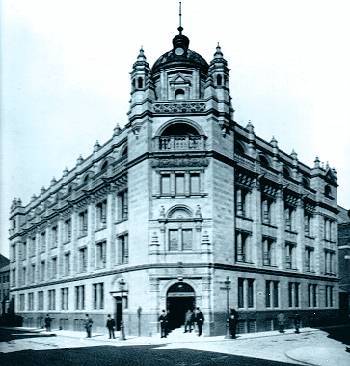
My father worked for this Company for his whole life. They made
all kinds of elastic webbing and their factory was in Rutland
Street. During the war they published a magazine to link their
employees who were in the forces with the factory and those still
at work.
After the war my mother did homework for the firm. Every week
brown fibre boxes were delivered full of elastic and suspender
fittings. Her job was to thread the elastic onto the suspenders.
It was an early introduction to ladies suspenders but I could
never understand why anyone would find them erotic.
I know she was paid very little but every little helped in
those days.
Church in Fosse Road. Although we lived in the parish of St.
Leonards, my father prefered St Augustines and it was the 'family'church.
We all went to Sunday school there and I eventually sang in
the choir. At 16 I rejected religion totally. Most family wedding,christenings,funerals
etc took place at this church. It was never a beautiful place
being built of red brick and with wild overgrown gardens could
be a bit spooky.
The Schoolrooms nearby were the place where all family wedding
receptions were held and where I went to Sunday school until
I discovered that if I 'bunked off' nobody noticed and I spent
a many Sunday afternoons wandering around the city when my parents
thought I was at Sunday School.
In March 2004, a fire destroyed most of the church.Eric would
have been very upset to know this happened as he was very attached
to the place.
Fosse Cinema
Lovely cinema in Fosse Road. Far superior to the two other
locals, the Tudor and the Sovereign. It had a proper balcony
with a waiting lounge, beautiful curtains with constantly changing
coloured lights across the screen and a thirties decor.
My Aunt Nora worked as a cashier and usherette. Had a good fish
and chip shop opposite. Still in use for bingo.
2004. I am told the cinema has now disappeared and is now a
Tesco store. Pity as the inside was a beautiful building and
should have been preserved. 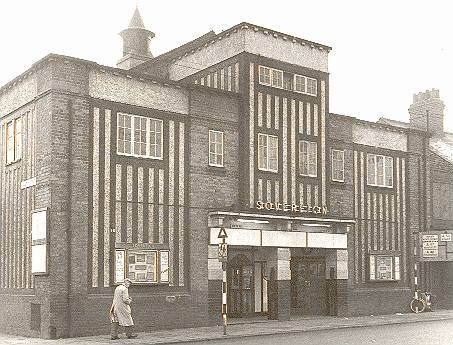
Sovereign Cinema
Small cinema in Woodgate. Very popular and always full. Films
tended to be a bit scratched when they finally arrived here
after ending their sun at the 'up town' posh cinemas.but the
audience did not seem to mind. The cheapest seats at the front
either gave you a neck ache or if you sat at the side, everyone
on the screen had elongated heads. I have even seen films here
with the reels in the wrong order and nobody seemed to mind.
Breaks in the film were also common because of the worn nature
of the prints.
Mrs. Webb sold tickets and later served Ice Creams and Kiaroa
orange squash. As she was a neighbour she would sometimes let
us in free of charge. With Aunt Norah doing the same at the
Fosse, we often got free seats.
The posh part, 'upstair' was not a proper gallery but just
rows of seat built over the box office and foyer underneath.
The manager wore evening dress and came round before the performance
spraying the air with a perfumed (or antiseptic ?) spray.
Was served by two fish and chip shops which were an essential
part of an evening out.
Converted into shops and a warehouse eventually but the building
is still there.
Back to top of page
Tudor Cinema
Long narrow cinema off Tudor Road which was unique in not issuing
tickets but metal tokens to show the usherettes which seats
you had paid for. Had a very popular childrens matinee on Saturdays
which my mother considered a bit rough, but I still went. Eventually
it closed and became a warehouse.
The Blackbird
Large modern pub with a beer garden on Blackbird Road. Considered
a little more upmarket compared with the Robin and other pubs
in Woodgate. I always thought it totally lacked any atmosphere
and was as exciting as a doctors waiting room
The Robin Hood
Rather down market pub in Woodgate. I can still smell the beer
and smoke fumes which came out of the open windows and which
overwhelmed passers by. It always seemed though, in contrast
to the Blackbird, an 'interesting' place
Alderman Richard Hallan School
A very modern school for the times which I went to. Built on
a hill with a long drive running up to it. Terrible to get up
to first thing in the morning but great to run down on the way
home.
Had huge sports fields which were later taken away and used
to build houses in less enlightened times. Had seperate Infants
and Junior departments
Back to top of page
Abbey Park
Very large and impressive park in the centre of the city with
the river Soar running through the middle and containing the
ruins of Leicester Abbey one time home of Cardinal Wolsley.
Had a large childrens play area, a boating lake and two pavilions
plus a bandstand. It was a short walk from where we lived and
we visited it on a regular basis.
A fine example of the attitude of the City Councils of the
prewar period who had a pride in the city unlike the post war
generation who pulled it's heart out.On my last visit, the signs
of cost cutting were very apparent with poor flower displays
and a general feel of a lack of TLC
Fosse Park
Very plain park on Fosse Road with swings which were usually
broken. Considered a bit rough by my mother. We just thought
it was dull.
Mrs Hill's
Green grocers on Groby Road. Grew a lot of her stock in greenhouses
out the back. Her tomatoes, I can still taste.
Co-op
Modern store at the bottom of Groby Road. Two long counters
where staff packed bulk stuff into smaller blue packet, cut
cheeses, sliced butter and bacon. Lovely smell. My mother used
it a lot to get her 'dividend' I knew the dividend number better
than my own name. Had a seperate butcher's shop next door.
Olive was always complaining about it but never stopped using
it.
After the war was one of the first stores in the city to become
self service.
Back to top of page
Tires
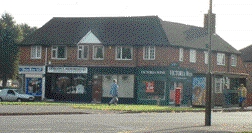
Green grocer at top of Buckminster Road. My mother never liked
this shop for some reason although the son, Brian, was in my
class at school. I often went there to fetch vinegar for my
mother which was poured out of a large barrel into a bottle.
It was part of a small group of shops including one where we
could buy crusty cobs and Tizer. The photograph shows the shops
as they are today. Tires was the second shop from the right
County Dairy
Grocers at the bottom of Groby Road. Had a sweet shop next
door which was far more interesting especially when they actually
had some sweets to sell.
Royal Infirmary
Hospital where my mum was a regular visitor for treatment for
her leg and arm. I hated going with her as the place frightened
me. I still have a basic fear of hospitals and hate the smell.
Groby Road Hospital
Used as a TB isolation Hospital until TB became a thing of
the past. Also had an assylum at the back and groups of inmates
with their funny ways out for walks with their nurses were a
familiar sight.
Back to top of page
Bradgate Park
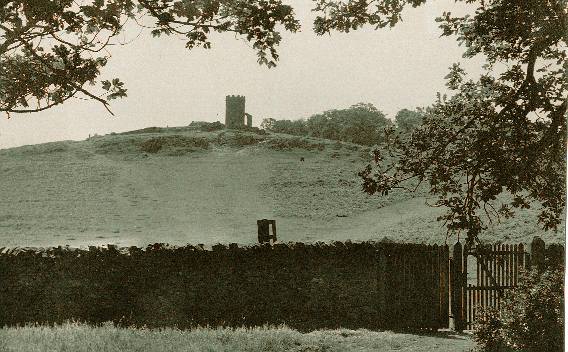
Lovely park outside the city and one time home of Lady Jane
Grey who was beheaded by Henry the Eighth. Has deer roaming
around, rocks to climb, water to splash in. Buses went from
Saint Margarets bus station and were always so full at weekend
it was sometimes difficult to get there. Dominated by a strange
ruin called 'Old John' which stands on top of a hill and looks
like an upturned beer mug.
Even since leaving Leicester, I have occasionally visited the
top of 'Old John' when I wanted peace and quiet to think over
something important. A place I would also like my ashes scattered
when I depart this life.
Back to top of page
Gilroes
Cemetary on Groby Road. We often visited on Sundays as a family
to put flowers on the graves of grandad Mason and others. I
never saw this as a cheerless outing as the place was very attractive.
Olive and Eric's ashes were scattered here.
Groby Pool
Artificial lake near village of Groby. Often iced over in the
winter and used for skating.Popular Sunday outing during the
summer.
Coalville
Small coal mining town where my Aunt Aggie lived with her husband
Ernie. despite the presence of mining she lived to be over 100
years old.
Clock Tower
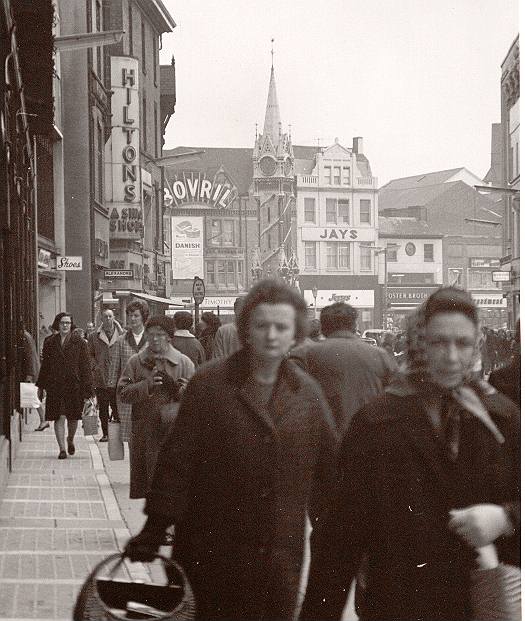
Symbol of the City. A tall tower with a four sided clock in
the very centre of the city.
Highfields
Home for my Grandmother and father and their family. It was
a poor area even then and continues to this day to be despite
huge clearances of old property including my Grandad's shop.
Suffered bombing raid in 1940. Home to first black arrivals
in the city and later Asians from East Africa. Today very much
home to families whose origins are in East Africa.
The Pool
Short name for Newfoundpool, an estate of houses built off
the Fosse road. These were on the whole larger terrace and Villa
type houses and superior to those in the nearby Tudor Road area.
My fathers family lived here at the top end near Ingle Street
School and my father's sister, Norah, lived in Oban street after
her marriage. My cousin Peggy also lived here after her marriage
to Les and after the war our neighbours, the Woodcocks, moved
to the Pool to open a bread and cake shop.
Back to top of page
Theatre Royal
Theatre in the Town Hall square. Demolished post war to make
way for a building society office. An act of vandalism of which
Leicester's developers were allowed far too many.
Floral Hall
Pretty rough cinema in same block as the Palace variety theatre.
Located in Belgrave gate.
The Palace
A variety theatre in Belgrave gate. Demolished after the war
after ending up showing nothing but cheap 'revues'mainly consisting
of scantilly dressed girls.
I remember seeing people such as Harry Seccombe here doing
his 'shaving' act
Odeon
Very modern cinema in Rutland Street with art deco styling.
Gained some fame post war as the place Leicester's best know
playright, Joe Orton was first seduced. Now sadly rotting away
and boarded up.
Gaumont (The City)
Large cinema in the Market area. Not as grand inside as the
Odeon or the Savoy but popular. Often allowed films such as
The Sound of Music to run for long periods ulike today when
even first class films disappear after a few weeks.
Picture House
Strange long, thin cinema in Granby Street. Had problems after
the war when Cinemascope came in as there was not enough width
for a proper Wide screen
Back to top of page
Savoy
One of Leicester's finest cinemas and one I always enjoyed
visiting. There was an organ which came up from the floor although
during the war it was rarely if ever used. The decor was wonderful.
Destroying these cinemas was an act of vandalism even though
much of the structure probably survives under the multiscreen
conversion jobs.
On a recent visit to the city I was sad to see it boarded up.
Another example of a city detroying it's heritage.
Opera House
Leicester's finest theatre again destroyed after the war in
another act of vandalism.An annual visit to the pantomime here
was a must for most families even if it mostly mean't a wooden
bench seat in the 'gods'.
Frears and Black
Bakery in Abbey Lane.Always a great smell of baking bread.
Our bread was delivered by their roundsman every day together
with cakes although my mother turned her nose up at 'shop bought'
cakes and pastries. Famous for it's 'topsy' sliced bread. Olive
considered it's products superior to those from the Co-op !
Central Station
The LNER station for London Marylebone. An impressive station
but always considered second best to the Midland rival. Remains
of Roman mosaic in basement under the station always fascinated
me as did the nearby Roman Forum. During the night with my bedroom
window opened (winter and summer) I could here the whistles
of the trains as they sped through the night.
Back to top of page
Belgrave Road Station
The Great Northern station used mostly for excursion trains
to Mablethorpe and Skegness. These used the oldest carriages
around and were always packed. The trains were very popular
but very slow and sooty. Now totally gone with all trace removed.
Midland Station
In London Road and the main station for the city with services
to the North and South. At the back of the station was Swain
street bridge and Birdcage walk where we went to spot trains.
My parents always pointed out the old workhouse building near
the bridge as some kind of warning. It was on the Midland station
while meeting my sister off the London train that I heard of
the death of John Kennedy
St. Margarets Bus Station
Very modern, for the times, bus station using concrete as it's
main constructional material. We mainly used it to catch buses
to Bradgate park.
Sadly now demolished and a modern bus station stands in it's
place with little character
Leicester Mercury and Leicester Evening
Mail
Two local newspaper. The Mercury was considered more 'middle
class' and the Mail a bit 'downmarket' Olive and Eric had the
'Mercury' but many relatives prefered the Mail. After the war
I had a job delivering these papers and the Mail always annoyed
me because the very black ink made my hands filthy.
The Chip shops
For us as kids, the chip shops were the McDonalds of the day.
We were lucky we had lots and knew the differences between them.
The first was Dunton Street. Their chips were greasy and pretty
yucky but they gave a good portion . Woogate was busy and often
had a queue, a fact which benefitted Dunton Street. Their chips
were OK and they served fritters and scratchings.(bits of fried
batter which had fallen off the fish)
The best quality shop was in Fosse Road opposite the Fosse cinema
but if usually had a queue and this benefitted two shops in
Tudor Road. The first near the Fosse Road junction was pretty
bad and had few customers for their soggy offering. The
one half way along was better and OK if you had been to the
Tudor cinema, but a bit far to walk otherwise. We never bought
fish, it was too expensive, but sometimes my mum would splash
out.
Pies were not sold until the fifties when 'Fleur de Lys' steak
and kidney pies becane popular.
Switherland

Switherland was a wooded area to the west of the city close
by Bradgate. There was a popular camp there with wooden chalet
type holiday homes where people from leicester could go for
a break. Facilities were primitive but at the time a few days
spent here was a real adventure. The thought of going abroad
had never even entered anyone's head !
Glenfield Tunnel
Glenfield tunnel was once the longest railway tunnel in the
UK. It was close to where we lived and we loved climbing down
onto the single track railway and waiting for the ancient old
engine which pulled a long line of coal trucks up and down the
line several times a day. I still have a little of that railway
embeded in my knee. I fell over on the track one day cutting
my knee open and when it healed some of the cinders was trapped
under the skin and to this day still causes a small red patch.
The railway itself was one of the first to open in Britain
and brought coal from the Swannington area down into the city.
Since it's closure, the track bed had all but disappeared covered
by Wimpy type houses. The Tunnel is, I understand boarded up,
but still there.
Back to top of page

|

